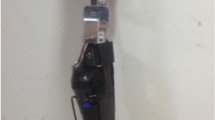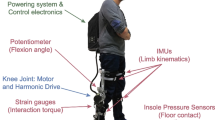Abstract
Application of intermittent control of the knee joint stiffness in a knee ankle foot orthosis (KAFO) during gait is proposed. The approach combines inertial sensors and an actuator system in order to apply compensation in quadriceps weakness with a wearable device. Two methods, segment-angular rotation based and segment-angular velocity based, are analysed for the control of the knee joint state (intermittent stiffness) based on the inertial sensors signals. Protocolled tests are developed with two post-polio syndrome patients (PPS). In this study, the cases of gait with free-swinging leg and safe stance with the orthotic system are presented in terms of quantified kinematics (average peak angle of knee flexion of 50°) and evidences of reduction of frequent compensations (e.g. leg lateral movement) in post-polio syndrome patients. The results from immediate inspection indicate an important improvement of the gait patterns in two patients with proximal leg weakness by means of compensations applied by the wearable orthosis.





Similar content being viewed by others
References
Baten C et al (2004) Use of inertial sensing in an intelligent orthosis. A feasibility study, presented at the Esmac Conference. Warswaw, Poland
Baydal JM et al (2006) Performance validation of an innovative orthotic knee joint based on an optimal four bar linkage. Orthopadie-Technik Quarterly 2:6–11
Blaya J, Herr H (2004) Adaptive control of a variable-impedance anklefoot orthosis to assist drop foot gait. IEEE Trans Neural Syst Rehabil Eng 12:24–31
Ferris D et al (2006) An improved powered ankle foot orthosis using proportional myoelectric control. Gait Posture 23:425–428
Franken HM (1995) Cycle to cycle control of swing phase of paraplegic gait induced by surface electrical stimulation. Med Biol Eng Comput 33:440–451
Gharooni S, Heller B, Tokhi M (2000) A new hybrid spring brake orthosis for controlling hip and knee flexion in the swing phase. IEEE Trans Rehabil Eng 9:106–107
Goldfarb M, Durfee WK (1996) Design of a controlled-brake orthosis for FES-aided gait. IEEE Trans Rehabil Eng 4:13–24
Hornby T, Zemon D, Campbell D (2005) Robotic-assisted, body-weight-supported treadmill training in individuals following motor incomplete spinal cord injury. Phys Ther 85:52–66
Irby S, et al (1999) Optimization and application of a wrap-spring clutch to a dynamic knee-ankle-foot orthosis. IEEE Trans Rehabil Eng 7:130–134
Kameyama O, Suga T (1998) Newly designed computer controlled knee-ankle-foot orthosis. Prosthet Orthot Int 22:230–239
Kaufman KR, Irby SE, Mathewson J, Wirta RW, Sutherland DH (2006) Energy-efficient knee-ankle foot orthosis: a case study. J Prosthet Orthot 8(3):79–85
Kazerooni H, Steger R, Huang L (2003) Hybrid control of the berkeley lower extremity exoskeleton. Int J Robotics Res 25(5–6):561–573
Kazerooni H, Steger R, Huang L (2003) Hybrid control of the Berkeley lower extremity exoskeleton. Int J Robotics Res 25:561–573
Kirtley C (2003) Automated diagnosis of gait abnormalities. Presented at biomechanics of the lower limb in health, disease and rehabilitation, Manchester
Luinge HJ, Veltink PH (2005) Measuring orientation of human body segments using miniature gyroscopes and accelerometers. Med Biol Eng Comput 43(2):273–282
Meijer K, Moreno JC, Savelberg H (2005) Biomimetics—biologically inspired technologies. Chapter 2: biological mechanisms as models for mimicking—sarcomere design, arrangement and muscle function. CRC, Boca Raton
Moreno JC et al (2006) Simulation Of knee function during gait with an orthosis by means of two springs of different stifnesses. Gait Posture 21:S140
Moreno JC et al (2006) Design and implementation of an inertial measurement unit for control of artificial limbs: application on leg orthoses. Sens Actuators B Chem 118:333–337
Perry J (1999) Gait analysis: normal and pathological function, McGraw-Hill Inc
Veltink PH et al (1996) Detection of static and dynamic activities using uniaxial accelerometers. IEEE Trans Neural Syst Rehabil Eng 4:375–385
Williamson R, Andrews BJ (2001) Detecting absolute human knee angle and angular velocity using accelerometers and rate gyroscopes. Med Biol Eng Comput 39(3):294–302
Winter D (1991) The biomechanics and motor control of human movement. University of Waterloo
Yakimovich T, Kofman J, Lemaire ED (2006) Design and evaluation of a stance-control knee-ankle-foot orthosis knee joint. IEEE Trans Neural Syst Rehabil Eng 14(3):361–369
Acknowledgments
The authors would like to thank L. Bueno for his work and assistance in the development of the control architecture and J. Baydal, W. de Vries and V. Erren, for their enormous contributions in testing and experimentation. The work presented in this paper has been partially founded through grant IST-2001-37751 of the European Commission.
Author information
Authors and Affiliations
Corresponding author
Rights and permissions
About this article
Cite this article
Moreno, J.C., Brunetti, F., Rocon, E. et al. Immediate effects of a controllable knee ankle foot orthosis for functional compensation of gait in patients with proximal leg weakness. Med Bio Eng Comput 46, 43–53 (2008). https://doi.org/10.1007/s11517-007-0267-x
Received:
Accepted:
Published:
Issue Date:
DOI: https://doi.org/10.1007/s11517-007-0267-x




